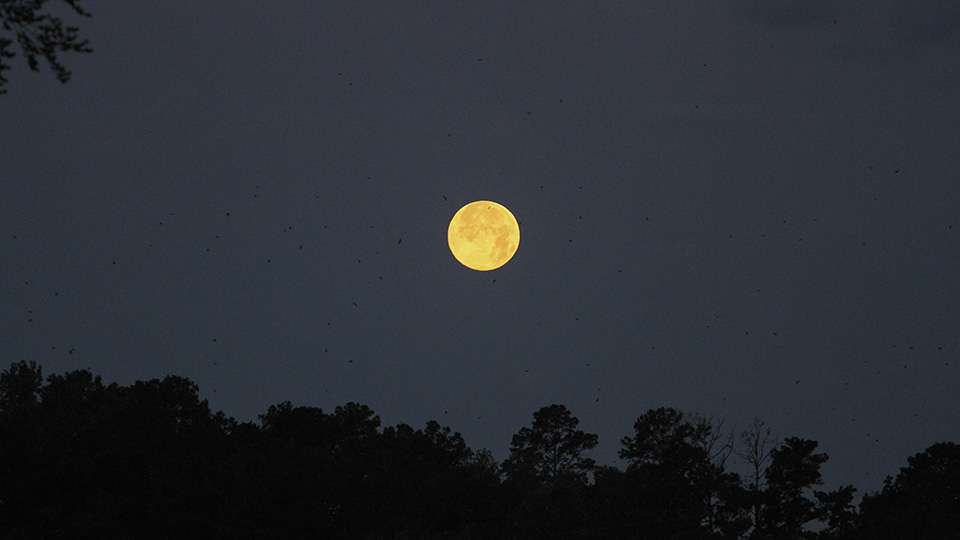
The Roman moon goddess Luna took her name from a Latin word, lucere, which describes illumination. Most bass anglers have already made the mental connection to the moon cycle here, but Bassmaster Elite angler Josh Stracner says “not so fast.”
In simplest terms, the amount of moon seen from Earth changes throughout the month because our only natural satellite orbits the planet while the planet orbits the sun. The full moon bears undeniable impact on bass spawning, but as Stracner notes, there’s more to the story.
“I’ve always paid attention to lunar tables — the major and minor feeding periods — but over the past four to five years, I’ve noticed that the new moon can affect the fish just as much as a full moon,” Stracner said. “That couple of days before and after a full moon, everybody knows that affects the spawn and the feeding patterns. But I think a lot of anglers miss out on the new moon’s impact on the spawn.”
Case in point, prior to the cutoff for the 2022 Elite season opener on the St. Johns River, Stracner was putting in some final pre-practice time about two days before a new moon. The weather was stable, and he spotted a bass making a bed midday.
Stracner’s deduction: With water temperatures getting right, the fish were ready. But lacking overnight illumination, there probably wasn’t much after-hours activity.
“The daytime bite and the spawning are best during a new moon, because they’re in the dark all night, so they don’t do as much during the night,” Stracner said. “It makes sense because they have overhead light during a full moon. They’re busy building their bed, feeding and guarding.
“When conditions are right, the fish want to spawn; they don’t just sit there waiting for a full moon. There’s a peak in that new moon cycle and that triggers them to spawn.”
Night light
Florida Elite John Cox agrees with that assessment, so much so that he’s adamant about knowing what the moon is doing the night before a tournament day.
“When a night has a big full moon, when it’s so bright it looks like daytime, you get a push of fish through the night,” Cox said. “As long as the water temperature is right, like 64 degrees and above, you’ll get a movement of fish that comes up at night.
“You’ll get out there the next morning, and you’re like ‘I saw a 2-pounder there (yesterday) and there’s three fish there.’ It seems like the more light they have overnight, the more they’ll pull up and be on beds the next morning.
“Now, if it’s a real cloudy, dark night that next morning, I feel like I don’t see as many new ones up there.”
Also referencing the 2022 St. Johns River Elite, Cox attributes a big chunk of his fourth-place finish to a Semifinal Saturday whack fest that was clearly prompted by the overnight spotlight.
“The night after Day 2, it was clear, the moon was out and it looked like daylight in the middle of the night. I went into Day 3 and went to an area where I had only seen one fish the day before and caught 30-plus pounds. Every bed had a fish on it.”
Sunshine State schedule
Nowhere else will you find spawning season diversity as much as Florida. Sunshine State bass certainly will spawn on full moons — that influence remains relevant — but as Scott Martin points out, seasonal conditions consistently hold more significant sway.
“You also pay attention to the moon, but they don’t react to the moon here as much as they do to the (conditions) lining up, meaning water clarity, water temp and not a lot of wind,” Martin said. “When you have that, it doesn’t matter what the moon is doing; it’s going to happen.”

From several decades of guiding and competing on Lake Okeechobee, as well other Florida favorites, Martin knows that a water temperature range of 62-72 degrees plus clear water is the reliable formula for Florida bass spawning. The Sunshine State fish generally need a cold front to get them ready, but when that chill yields to a handful of warm, calm days, bass will be spawning somewhere — regardless of moon phase.
“Fish in Florida are unique in that they can spawn year-round. I’ve caught fish on Lake Okeechobee that had roe in them in August. Our fish can spawn at any phase of the moon. I just think it comes down to water temperature, water clarity or the amount of water they have to spawn in.”
Bernie Schultz, of Gainesville, Fla. agrees and adds this: “Over my 50-something years of bass fishing, I’ve found that the full moon is pretty consistent for bringing in a new wave of spawners, provided all the other factors are right.
“But that’s not to say it’s the only time. I’ve seen fish come in when the moon phase wasn’t a factor. In some cases, it wasn’t about water temperature as much as it was water level stabilizing,” Schultz continues.
Know your moon cycle
Notwithstanding the 1984 Duran Duran hit, “New Moon on Monday,” a new or full moon can occur any day of the week. When either of these stages coincide with the perigee — the moon’s closest distance from earth — we get the super moon. Think Friday night high school football stadium.
Another notable occurrence is a blue moon. Two definitions here: The monthly version is defined as the second full moon in a calendar month containing two. This can play handily during the spawn.
The seasonal blue moon is the third full moon of an astronomical season that has four. Contrasting the meteorological seasons, which are stated by calendar dates, astronomical seasons are defined by the spring and fall equinoxes.
If you’re planning, the next super moon is set for Aug. 1, 2023, with the next monthly blue moon occurring Aug. 30/31, 2023. We’ll have to wait until Aug. 19/20, 2024 for another seasonal blue moon.
Since we’re naming moons, consider this monthly list from the Old Farmer’s Almanac:
January – Wolf Moon
February – Snow Moon
March – Worm Moon
April – Pink Moon
May – Flower Moon
June – Strawberry Moon
July – Buck Moon
August – Sturgeon Moon
September – Corn Moon
October – Hunter’s Moon
November – Beaver Moon
December – Cold Moon
Notably, the September or October full moon may also be called a Harvest Moon, a bright moon that can last multiple days. The timing is based on when the full moon nearest the autumnal (fall) equinox occurs. Given the fact that Florida bass can spawn just about any time of the year, the Harvest Moon could become a factor.
Also worth mentioning, the Almanac explains that April’s Pink Moon coincides with the seasonal blooming of a pink wildflower known as creeping phlox, or moss phlox. This lunar phase is also called the Pascal Moon, because the timing establishes the date of Easter celebration — always the Sunday following a Pink moon.
The big takeaway for bass fishermen: April delivers spring’s first full moon and that’s always a relevant spawn consideration.
For any month, it’s important to note that spring’s meteorological moodiness can put the kibosh on the most promising spawning situation, regardless of lunar alignment. If you’re thinking “cold front,” you’re not wrong. While those dreaded post-frontal bluebird skies will shut down the whole deal, consider how a storm system often preceding a front can crash the party.
“If you get a really strong storm with a lot of lightning overnight when they’re trying to spawn on a full moon, that will push them off,” Stracner said. “On a dirtier lake, that’s not such a big deal, but on a clear water lake like Lake Martin, they don’t like that light flashing through the water column. It messes them up for a day or so.”
Thankfully, southern spawners are an adaptive lot. If it doesn’t go down when originally planned, the fish will reschedule and get it done.





